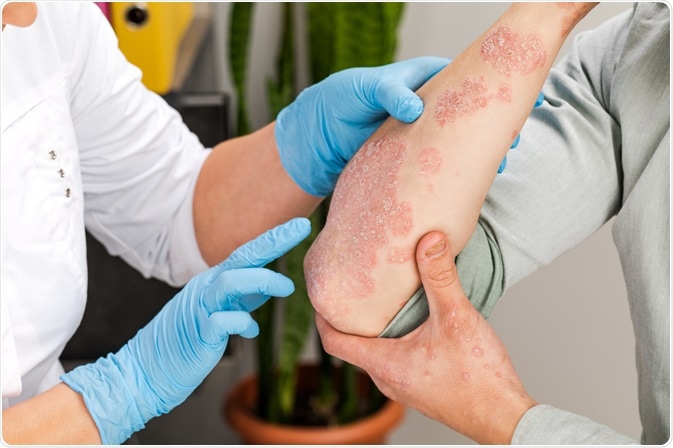As psoriasis is a very broad condition with varied signs and symptoms among different patients, it is useful to classify the condition to help guide the appropriate treatment decisions.
Psoriasis can be classified by type, evidence of pustules, pathogenetic cause, affected body area, and severity.

Image Credit: Fuss Sergey / Shutterstock.com
Types of psoriasis
The morphological presentation and type of psoriasis can be used to classify the condition into a number of categories. These different types are categorized by their unique histological characteristics.
- Plaque psoriasis (psoriasis vulgaris)
- Generalized pustular psoriasis
- Acrodermatitis continua
- Pustulosis palmaris/plantaris
- Guttate psoriasis
- Psoriatic arthritis
- Psoriatic spondylitis
- Inverse psoriasis
Pustular classification
The evidence of pustules, which are red and painful bumps filled with pus, in the affected area can also be used to further classify the condition. Psoriasis can either be pustular or non-pustular, depending on the presence of the bumps.
Pathogenetic cause
Psoriasis can also be classified according to the causative pathogenetic factors, as outlined below:
- Type 1: Onset before the age of 40 with positive family history of psoriasis, associated with HLA-Cw6.
- Type 2: Onset before the age of 40 with no family history of psoriasis and no antigen association.
Some cases of psoriasis are also associated with the use of pharmaceutical products, known as drug-induced psoriasis.
Severity by body area
Classifying cases of psoriasis according to severity is a common technique and is often used in practice to help guide the appropriate treatment and management of the condition.
- Mild psoriasis: Less than 3% of the body is affected.
- Moderate psoriasis: Between 3 and 10% of the body is affected.
- Severe psoriasis: More than 10% of the body is affected.
This crude method of classifying the severity of the condition is easy to use, as it can be estimated in practice. For reference, the palm of the hand is approximately 1% of the body surface area.
Severity Iindex
Although the affected body area can give a good indication of the severity of the disease, the psoriasis area severity index (PASI) is a measurement tool that is more widely used due to it incorporation of other aspects of the condition.
PASI assesses both the area of the body that is affected and the severity of the affected lesions to create a combined score within the range of 0 to 72. Whereas a score of 0 will represent a healthy person without disease, a PASI score of 72 is considered the maximal level of disease.
However, this scale is more complex and can be difficult to implement in everyday clinical practice. It is commonly used in research; however, working health professionals often use simpler methods of severity classification, such as body area.
References
Further Reading
Last Updated: Apr 8, 2023